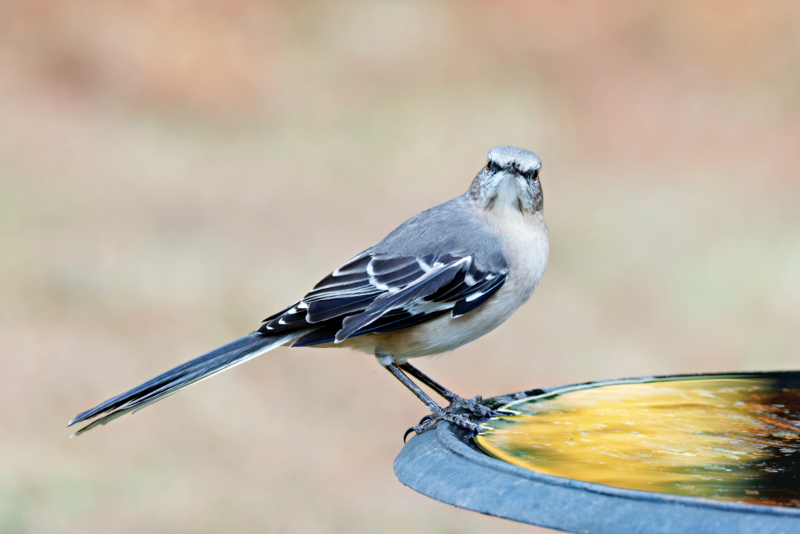Yesterday, as I sat outside in my yard here in Arkansas, I had an encounter with one of the most familiar songbirds of the region, the Northern Mockingbird. Perched confidently on the edge of my birdbath, this mockingbird seemed to have a curious and almost inquisitive look on its face as it stared directly at me. The moment was brief but special, and I couldn’t resist capturing it.

Why Northern Mockingbirds Are So Fascinating
Northern Mockingbirds are known for their incredible ability to mimic the songs of other birds, and even the sounds of insects, amphibians, and machine-made noises. They are vocal virtuosos, often heard singing both day and night, especially during the breeding season. But what always catches my attention is their bold, observant behavior. Whether they are defending their territory or simply exploring, they never seem shy.
In this photo, the mockingbird’s stance and sharp gaze give the impression that it’s both aware and unbothered by my presence. It’s not unusual to see these birds acting with such confidence; they are known for fiercely protecting their nests and will even chase away much larger birds, or humans, for that matter, if they feel threatened.
A Reliable Visitor to My Yard
Mockingbirds are year-round residents in Arkansas, and I’ve noticed that they are frequent visitors to my yard, especially around my birdbath. Like this one, many seem to enjoy a quick drink or even a splash. My birdbath has been a hub of activity lately, with birds and even squirrels stopping by.
One reason these birds keep coming back could be that I keep the birdbath clean and filled, making it a reliable water source during the warmer months. Yesterday was no different—the temperatures have still been high for October, and I imagine this mockingbird appreciated the refreshing water.
Behavior and Personality
Mockingbirds, in general, are quite territorial, and I’ve seen them chase off other birds that get too close. This one, however, seemed relaxed, almost as if it was taking a moment to observe its surroundings before flying off to its next destination. They are also known for their intelligence, and some believe that they can recognize familiar faces. Maybe that’s why this one gave me such a piercing look, as if it knew I was watching and photographing it!
Why I Love Mockingbirds
What I love most about mockingbirds is their resilience and adaptability. Whether it’s mimicking the calls of other birds or thriving in both rural and urban settings, these birds seem to know how to make the most of any environment. Plus, their personalities really shine through once you spend some time observing them.
For any bird enthusiast, the Northern Mockingbird is a delight to watch, listen to, and, in moments like this, photograph. They are a reminder of how rich our local birdlife can be if we just stop and pay attention.
Attracting Northern Mockingbirds to Your Yard
If you’re hoping to attract Northern Mockingbirds to your own yard, here are a few tips:
- Provide a birdbath: Like in my photo, water sources are key to keeping birds around, especially in the warmer months.
- Plant berry-producing shrubs: Mockingbirds love to eat berries, so planting species like holly, mulberry, or blackberry can be a natural attractant.
- Leave some open space: They prefer areas where they can perch openly, so a mix of shrubs and open yard areas can be ideal for them.
- Offer insects: These birds also enjoy snacking on insects, so an insect-friendly yard (one without harsh pesticides) will keep them interested.
Northern Mockingbirds are a staple of Southern backyards, and I feel lucky to share my outdoor space with them. I’m sure this won’t be the last time I find one staring me down from the birdbath!
Do you have any interesting encounters with Northern Mockingbirds in your area? I’d love to hear about it!
